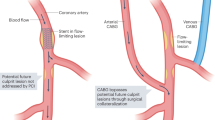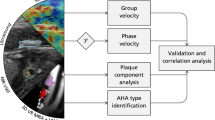Abstract
Atherosclerosis is characterized by thickening of the walls of the arteries, a process that occurs slowly and 'silently' over decades. This prolonged course of disease provides a window of opportunity for diagnosis before symptoms occur. But, until recently, only advanced atherosclerotic disease could be observed. Now, developments in imaging technology offer many enticing prospects, including detecting atherosclerosis early, grouping individuals by the probability that they will develop symptoms of atherosclerosis, assessing the results of treatment and improving the current understanding of the biology of atherosclerosis.
This is a preview of subscription content, access via your institution
Access options
Subscribe to this journal
Receive 51 print issues and online access
$199.00 per year
only $3.90 per issue
Buy this article
- Purchase on Springer Link
- Instant access to full article PDF
Prices may be subject to local taxes which are calculated during checkout


Similar content being viewed by others
References
Lusis, A. J. Atherosclerosis. Nature 407, 233–241 (2000).
Gershlick, A. H. et al. Role of non-invasive imaging in the management of coronary artery disease: an assessment of likely change over the next 10 years. A report from the British Cardiovascular Society Working Group. Heart 93, 423–431 (2007).
Hendel, R. C. et al. ACCF/ACR/SCCT/SCMR/ASNC/NASCI/SCAI/SIR 2006 appropriateness criteria for cardiac computed tomography and cardiac magnetic resonance imaging: a report of the American College of Cardiology Foundation Quality Strategic Directions Committee Appropriateness Criteria Working Group, American College of Radiology, Society of Cardiovascular Computed Tomography, Society for Cardiovascular Magnetic Resonance, American Society of Nuclear Cardiology, North American Society for Cardiac Imaging, Society for Cardiovascular Angiography and Interventions, and Society of Interventional Radiology. J. Am. Coll. Cardiol. 48, 1475–1497 (2006).
Sakuma, H. Magnetic resonance imaging for ischemic heart disease. J. Magn. Reson. Imaging 26, 3–13 (2007).
Kwong, R. Y. et al. Impact of unrecognized myocardial scar detected by cardiac magnetic resonance imaging on event-free survival in patients presenting with signs or symptoms of coronary artery disease. Circulation 113, 2733–2743 (2006).
Ibanez, B. et al. Early metoprolol administration before coronary reperfusion results in increased myocardial salvage: analysis of ischemic myocardium at risk using cardiac magnetic resonance. Circulation 115, 2909–2916 (2007).
Fenchel, M. et al. Atherosclerotic disease: whole-body cardiovascular imaging with MR system with 32 receiver channels and total-body surface coil technology — initial clinical results. Radiology 238, 280–291 (2006).
Hamon, M. et al. Diagnostic performance of multislice spiral computed tomography of coronary arteries as compared with conventional invasive coronary angiography: a meta-analysis. J. Am. Coll. Cardiol. 48, 1896–1910 (2006).
Budoff, M. J. et al. Assessment of coronary artery disease by cardiac computed tomography: a scientific statement from the American Heart Association Committee on Cardiovascular Imaging and Intervention, Council on Cardiovascular Radiology and Intervention, and Committee on Cardiac Imaging, Council on Clinical Cardiology. Circulation 114, 1761–1791 (2006).
Weustink, A. C. et al. Reliable high-speed coronary computed tomography in symptomatic patients. J. Am. Coll. Cardiol. 50, 786–794 (2007).
MacNeill, B. D., Lowe, H. C., Takano, M., Fuster, V. & Jang, I.-K. Intravascular modalities for detection of vulnerable plaque: current status. Arterioscler. Thromb. Vasc. Biol. 23, 1333–1342 (2003).
Lorenz, M. W., Markus, H. S., Bots, M. L., Rosvall, M. & Sitzer, M. Prediction of clinical cardiovascular events with carotid intima-media thickness: a systematic review and meta-analysis. Circulation 115, 459–467 (2007).
Greenland, P. et al. ACCF/AHA 2007 clinical expert consensus document on coronary artery calcium scoring by computed tomography in global cardiovascular risk assessment and in evaluation of patients with chest pain: a report of the American College of Cardiology Foundation Clinical Expert Consensus Task Force (ACCF/AHA Writing Committee to Update the 2000 Expert Consensus Document on Electron Beam Computed Tomography). Circulation 115, 402–426 (2007).
Naghavi, M. et al. From vulnerable plaque to vulnerable patient — part III: executive summary of the Screening for Heart Attack Prevention and Education (SHAPE) Task Force report. Am. J. Cardiol. 98, 2H–15H (2006).
Clouse, M. E. et al. How useful is computed tomography for screening for coronary artery disease? Circulation 113, 125–146 (2006).
Min, J. K. et al. Prognostic value of multidetector coronary computed tomographic angiography for prediction of all-cause mortality. J. Am. Coll. Cardiol. 50, 1161–1170 (2007).
Cordeiro, M. A. & Lima, J. A. Atherosclerotic plaque characterization by multidetector row computed tomography angiography. J. Am. Coll. Cardiol. 47, C40–C47 (2006).
Khera, A. et al. Relationship between C-reactive protein and subclinical atherosclerosis: the Dallas Heart Study. Circulation 113, 38–43 (2006).
Corti, R. et al. Effects of aggressive versus conventional lipid-lowering therapy by simvastatin on human atherosclerotic lesions: a prospective, randomized, double-blind trial with high-resolution magnetic resonance imaging. J. Am. Coll. Cardiol. 46, 106–112 (2005).
Naghavi, M. et al. From vulnerable plaque to vulnerable patient: a call for new definitions and risk assessment strategies: part I. Circulation 108, 1664–1672 (2003).
Saam, T. et al. The vulnerable, or high-risk, atherosclerotic plaque: noninvasive MR imaging for characterization and assessment. Radiology 244, 64–77 (2007).
Briley-Saebo, K. C. et al. Magnetic resonance imaging of vulnerable atherosclerotic plaques: current imaging strategies and molecular imaging probes. J. Magn. Reson. Imaging 26, 460–479 (2007).
Takaya, N. et al. Association between carotid plaque characteristics and subsequent ischemic cerebrovascular events: a prospective assessment with MRI — initial results. Stroke 37, 818–823 (2006).
Choudhury, R. P., Fuster, V. & Fayad, Z. A. Molecular, cellular and functional imaging of atherothrombosis. Nature Rev. Drug Discov. 3, 913–925 (2004). This review discusses different techniques for imaging the blood vessel wall, focusing on molecular imaging.
Wu, J. C., Bengel, F. M. & Gambhir, S. S. Cardiovascular molecular imaging. Radiology 244, 337–355 (2007).
Jaffer, F. A., Libby, P. & Weissleder, R. Molecular imaging of cardiovascular disease. Circulation 116, 1052–1061 (2007). This is an up-to-date review of cardiovascular molecular imaging, including a discussion of contrast agents that are in clinical testing.
Wickline, S. A., Neubauer, A. M., Winter, P. M., Caruthers, S. D. & Lanza, G. M. Molecular imaging and therapy of atherosclerosis with targeted nanoparticles. J. Magn. Reson. Imaging 25, 667–680 (2007).
Sosnovik, D. E., Nahrendorf, M. & Weissleder, R. Molecular magnetic resonance imaging in cardiovascular medicine. Circulation 115, 2076–2086 (2007).
Trivedi, R. A. et al. Identifying inflamed carotid plaques using in vivo USPIO-enhanced MR imaging to label plaque macrophages. Arterioscler. Thromb. Vasc. Biol. 26, 1601–1606 (2006).
Amirbekian, V. et al. Detecting and assessing macrophages in vivo to evaluate atherosclerosis noninvasively using molecular MRI. Proc. Natl Acad. Sci. USA 104, 961–966 (2007).
Hyafil, F. et al. Noninvasive detection of macrophages using a nanoparticulate contrast agent for computed tomography. Nature Med. 13, 636–641 (2007). This paper was the first to show selective visualization of macrophages by using CT.
Tawakol, A. et al. In vivo18F-fluorodeoxyglucose positron emission tomography imaging provides a noninvasive measure of carotid plaque inflammation in patients. J. Am. Coll. Cardiol. 48, 1818–1824 (2006).
Rudd, J. H. et al. 18Fluorodeoxyglucose positron emission tomography imaging of atherosclerotic plaque inflammation is highly reproducible: implications for atherosclerosis therapy trials. J. Am. Coll. Cardiol. 50, 892–896 (2007). This paper validates the reproducibility of concurrent PET and CT for the imaging of vascular inflammation.
Sirol, M. et al. Chronic thrombus detection with in vivo magnetic resonance imaging and a fibrin-targeted contrast agent. Circulation 112, 1594–1600 (2005).
Nahrendorf, M. et al. Noninvasive vascular cell adhesion molecule-1 imaging identifies inflammatory activation of cells in atherosclerosis. Circulation 114, 1504–1511 (2006).
Villanueva, F. S. et al. Myocardial ischemic memory imaging with molecular echocardiography. Circulation 115, 345–352 (2007).
Jaffer, F. A. et al. Optical visualization of cathepsin K activity in atherosclerosis with a novel, protease-activatable fluorescence sensor. Circulation 115, 2292–2298 (2007).
Winter, P. M. et al. Endothelial αVβ3 integrin-targeted fumagillin nanoparticles inhibit angiogenesis in atherosclerosis. Arterioscler. Thromb. Vasc. Biol. 26, 2103–2109 (2006).
Beeres, S. L. et al. Role of imaging in cardiac stem cell therapy. J. Am. Coll. Cardiol. 49, 1137–1148 (2007).
Flaumenhaft, R. et al. Localization and quantification of platelet-rich thrombi in large blood vessels with near-infrared fluorescence imaging. Circulation 115, 84–93 (2007).
Acknowledgements
This work was partly funded by the National Institutes of Health and the National Heart, Lung, and Blood Institute.
Author information
Authors and Affiliations
Ethics declarations
Competing interests
The authors declare no competing financial interests.
Additional information
Correspondence should be addressed to Z.A.F. (zahi.fayad@mssm.edu).
Rights and permissions
About this article
Cite this article
Sanz, J., Fayad, Z. Imaging of atherosclerotic cardiovascular disease. Nature 451, 953–957 (2008). https://doi.org/10.1038/nature06803
Published:
Issue Date:
DOI: https://doi.org/10.1038/nature06803
This article is cited by
-
Elucidating the mechanisms of formononetin in modulating atherosclerotic plaque formation in ApoE-/- mice
BMC Cardiovascular Disorders (2024)
-
Unraveling atherosclerotic cardiovascular disease risk factors through conditional probability analysis with Bayesian networks: insights from the AZAR cohort study
Scientific Reports (2024)
-
Ultrasonic barrier-through imaging by Fabry-Perot resonance-tailoring panel
Nature Communications (2023)
-
Conserved miR-370-3p/BMP-7 axis regulates the phenotypic change of human vascular smooth muscle cells
Scientific Reports (2023)
-
Ultrafast longitudinal imaging of haemodynamics via single-shot volumetric photoacoustic tomography with a single-element detector
Nature Biomedical Engineering (2023)
Comments
By submitting a comment you agree to abide by our Terms and Community Guidelines. If you find something abusive or that does not comply with our terms or guidelines please flag it as inappropriate.



